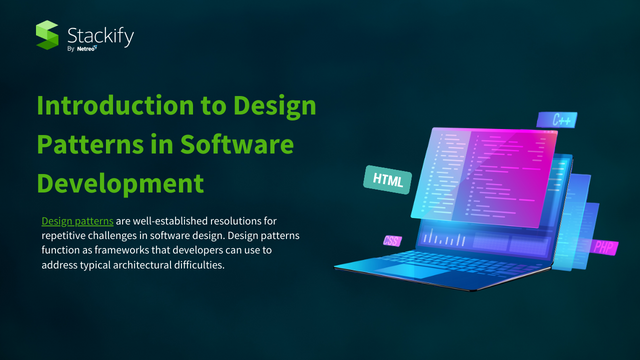Introduction to Design Patterns in Software Development

In the realm of software development, designing apps that are reliable and scalable is crucial. Design patterns are essential in achieving these objectives, being useful in OOP, UI and even QR Code design. The main reason is that design patterns offer reusable solutions to typical problems. This post explains the idea of design patterns, exploring their types, benefits and practical applications.
What are Design Patterns?

- Definition – Design patterns are well-established resolutions for repetitive challenges in software design. Design patterns function as frameworks that developers can use to address typical architectural difficulties. In addition, patterns guarantee dependability, adaptability and ease of code maintenance.
- Purpose – Design patterns aim to elevate software development practices by offering standardized solutions. Patterns are vital in organizing code, promoting reusability and simplifying the design process. By adhering to established patterns, developers can avoid unnecessary repetition and focus more on creating efficient, high-quality applications.
- Benefits – Implementing design patterns in software development yields numerous benefits. These include:
1. Code Reusability: Design patterns encourage the reuse of proven solutions, cut redundant code and save valuable development time. As a result, the use of design patterns improves production and efficiency in the software development process.
2. Scalability: Design patterns provide flexible structures. The structures can adjust to shifting needs and accommodate future expansions. This scalability ensures that software systems can grow without significant architectural overhaul.
3. Maintainability: By utilizing design patterns, code becomes more modular and easier to maintain. Developers can change specific software parts without impacting the entire application, which simplifies troubleshooting and updates.
4. Collaboration: Design patterns establish a widely-used language for developers, which also fosters effective communication and understanding of the software’s architecture. Communication enables seamless collaboration among team members, promoting synergy and collective problem-solving.
Types of Design Patterns
Creational patterns revolve around object-creation mechanisms and provide flexible ways to create objects, while promoting code encapsulation and decoupling.
- Singleton – A class can only have one instance, thanks to the Singleton design. It ensures a global access point as well. This pattern is proper when there should be a single class instance throughout the application.
- Factory – The Factory pattern abstracts the process of object creation and allows subclasses or derived classes to determine which class to instantiate. The Factory pattern also provides a central factory class that encapsulates object creation logic.
Structural patterns deal with the composition of classes and objects, defining how they can be combined to form larger structures or functionalities.
- Adapter – The Adapter pattern converts the interface of a class into another interface that clients expect, enabling types with incompatible interfaces to work together as a bridge.
- Decorator – The Decorator pattern dynamically adds new behaviors to an object by wrapping it in a decorator class. It offers a flexible alternative to subclassing for extending the functionality of an object.
- Behavioral Patterns – Behavioral patterns focus on communication and interaction between objects, plus define how objects collaborate to do complex tasks.
- Observer – The Observer pattern establishes a one-to-many dependency between objects. In this case, changes in one object trigger updates in other dependent things.
- Strategy – The Strategy pattern defines several interchangeable algorithms and encapsulates each separately. The pattern allows algorithms to be selected at runtime depending on their employed situation.
How to Use Design Patterns
Identifying the Problem
To effectively leverage design patterns, it is crucial to identify the problem or scenario that requires a solution. This approach entails understanding the software architecture‘s requirements, constraints and potential areas for enhancement.
Selecting the Appropriate Pattern
Once the issue has been identified, the following step is carefully selecting the most appropriate design pattern. Each pattern serves a distinct purpose within a specific context. That’s why it is important to consider scalability, maintainability and code complexity.
Implementing the Chosen Pattern
Once the design pattern has been chosen, developers can proceed with the implementation phase. This phase involves creating the necessary classes and interfaces and establishing the relationships the selected pattern specifies. Accompanying the implementation with proper documentation and code comments is crucial to ensuring clarity for future maintainers.
Real-World Examples
Design patterns are prevalent in various software applications. Let’s explore a few real-world examples highlighting the practical usage of design patterns:
- MVC (Model-View-Controller) Architecture: Developers widely employ this architectural pattern in web development frameworks. It separates the application into three components: the model (data and business logic), the view (user interface) and the controller (handles user input and orchestrates interactions between the model and view). MVC promotes code organization, modularity and ease of maintenance.
- Iterator Pattern: The iterator pattern is used in programming languages and frameworks that provide collections of objects. It offers a way to access elements of a group sequentially without exposing its internal representation. The iterator pattern simplifies the traversal of complex data structures, encapsulating iteration logic.
- Factory Pattern: Developers also widely deploy the factory pattern in software development to create objects without specifying their precise classes. The pattern provides an interface or base class for object creation. Subclasses or concrete implementations determine the specific performance. This pattern promotes loose coupling between client code and the objects it creates, facilitating flexibility and easier maintenance. A real-world example is a GUI toolkit. It utilizes the factory pattern to generate various graphical components based on user requirements or system configuration. For instance, buttons, text fields and checkboxes.
- Observer Pattern: The observer pattern provides a one-to-many dependency between objects, where the one (subject) notifies the many (observers) about any state changes. This pattern is commonly employed in event-driven systems or frameworks where many objects must respond to changes in other areas of the application. For instance, in a stock market application, various components like stock price displays, charts and notifications can act as observers that receive updates from a central stock market data source. The observer pattern enables loose coupling between the subject and observers, allowing dynamic and flexible interactions.
Conclusion
Design patterns are indispensable tools for software developers. They provide reusable solutions to recurring design challenges. By leveraging design patterns, developers can enhance code reusability, scalability and maintainability. Familiarity with various design patterns and their appropriate usage empowers developers to build efficient and robust software applications.
To use design patterns effectively, developers must first identify the problem or scenario that requires a solution. When the problem is identified, the most fitted design pattern can be selected. The implementation phase involves creating the necessary classes and interfaces and establishing the relationships specified by the chosen pattern.
Related posts:
- How to Evaluate Software Quality from Source Code
- How to Transform Software Estimation and Focus on Maximizing ROI
- The Golden Rule of Programming
- 52% of application issues took over half a day to fix – market research
- What is APM? Overview, Common Terms, and 10 Critical APM Features
Improve Your Code with Retrace APM
Stackify's APM tools are used by thousands of .NET, Java, PHP, Node.js, Python, & Ruby developers all over the world.
Explore Retrace's product features to learn more.
Elen is an experienced web content and report writer at LinkyJuice. She has a passion for creating engaging and informative articles, mainly specializing in SEO-optimized content and IT. With a background in marketing, she always writes copy that leaves a lasting impact on readers.
Get the latest news, tips, and guides on software development.
Join the community of 40,000 developers that subscribe to our newsletter.
By submitting your email address, you agree to be contacted via e-mail about our products and services. You can unsubscribe at any time.



